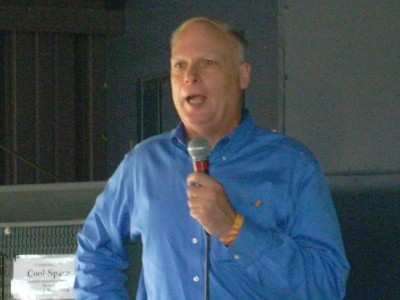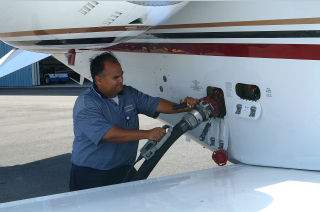Industry Stakeholders Working Through Complex System to Find
Solutions
By Maxine Scheer
The Government Affairs department of EAA organized a panel
Monday at AirVenture to bring light on the harsh reality that
regulations promulgated under the Clean Air Act are fast
approaching, and they will eventually prohibit the use of aviation
fuels that contain tetral-ethyl lead. Panelists included Glenn
Passavant, EPA Office of Transportation and Air Quality
Director-Nonroad Programs, Mark Rumizen, Aviation Fuels Specialist
in the FAA’s Aircraft Certification Division, Walter
Desrosier, Engineering and Maintenance, General Aviation
Manufacturers Association (GAMA), and Roger Gobin of Exxon Mobil,
Chair of the ASTM panel on Aviation Fuel.

Glenn Passavant
Glenn Passavant of EPA presented the results of the most recent
research on the health risks of lead. While it was acknowledged
that aviation’s contribution to the lead in the air we
breathe is very low percentage of total emissions, (< 0.33% per
~700 tons Pb/yr), he emphasized that EPA legislation will apply to
aviation fuel, as it did to automobile fuel back in 1990.
“Removing lead from automotive fuel was one of the
greatest accomplishments in cleaning air quality,” said
Passavant. “The evidence of the health-risks associated with
lead is significant…the most recent research, published in
October 2008, demonstrates that serious health risks occur with
much lower levels of lead in the blood than previously identified
– differences expressed by a factor of 10.”
 Avgas was given a reprieve in 1995, but petitions filed in 2006
required the EPA to focus on the aviation industry. Panelists
referenced looming deadline dates of January 2016 and January 2017
for the elimination of 100LL; the difference of which is based on
site monitoring.
Avgas was given a reprieve in 1995, but petitions filed in 2006
required the EPA to focus on the aviation industry. Panelists
referenced looming deadline dates of January 2016 and January 2017
for the elimination of 100LL; the difference of which is based on
site monitoring.
Passant noted that studies to monitor air quality around
airports are underway and based on results, could require actions
that accelerate dates for air quality attainment around airports
with large GA activity, primarily those airports that also suffer
from residential encroachment and/or those located near schools. An
estimated 3 million children attend schools within 1km of an
airport.
Glenn has been actively reaching out to the aviation community
to encourage a multi-disciplined industry plan to mitigate what
could be significant disruption and capital costs to the estimated
200,000 existing piston aircraft configured to use 100LL, half of
which are estimated by the Coordinating Research Council (CRC)
Unleaded AVGAS Development Panel, to require high octane fuel.
“The solution must be sustainable,” said Passavant,
“considering the life expectancy of most aircraft and the
downside risks associated with reliance on the oil
supply.” “Eventually, the regulatory path will
play out,” he continued, “unless aviation takes a
voluntary approach, like what happened with NASCAR.
FAA’s spokesperson, Mark Rumizen emphasized FAA’s
role as primarily focused on safety, the biggest issue obviously
being engine failure. FAA is funding research and participating in
a number of industry initiatives and is providing testing at its
Hughes Technical Center in Atlantic City.
Walter Desrosier with GAMA emphasized that this issue is high on
the radar screen of its members and provided attendees with an
overview of the CRC AVGAS Panel. Since 1990, the panel has looked
at over 200 fuels, performed full scale testing on 45 unleaded
blends and completed extensive research on about 20. He
acknowledged that most of the solutions involved some kind of drop
in additive. EPA’s Passavant argued that additives were not
the solution and emphasized other fuel options such as high octane
synthetics and biomass fuels, such as those being developed by
Swift. Passavant mentioned that there was a producer of a 91 octane
fuel in Sweden, but that its applications in the US were limited
given the diversity of the US piston fleet.

GAMA is championing the development of a strategic plan as a
decision making tool that considers the impacts to aircraft owners,
the level of involvement of FAA, and the costs associated with
development and delivery of the various fuel options.
“I’ve been looking at the aviation fuel issue since
1990, said Passant, and if you asked me then if we’d still be
using 100LL in 2009, I’d say no way.” The general
consensus from the panel was that this is a complex issue given the
life expectancy of most aircraft and the costs of a comprehensive
solution.
The issue has been on the table for nearly 20 years. The US is the
largest consumer of 100LL in the world and while significant effort
has been made in research and development, the rest of the world is
making changes while we continue to evaluate our options.
 ANN's Daily Aero-Term (04.26.24): DETRESFA (Distress Phrase)
ANN's Daily Aero-Term (04.26.24): DETRESFA (Distress Phrase) ANN's Daily Aero-Linx (04.26.24)
ANN's Daily Aero-Linx (04.26.24) Airborne 04.22.24: Rotor X Worsens, Airport Fees 4 FNB?, USMC Drone Pilot
Airborne 04.22.24: Rotor X Worsens, Airport Fees 4 FNB?, USMC Drone Pilot Airborne 04.24.24: INTEGRAL E, Elixir USA, M700 RVSM
Airborne 04.24.24: INTEGRAL E, Elixir USA, M700 RVSM Airborne-NextGen 04.23.24: UAVOS UVH 170, magni650 Engine, World eVTOL Directory
Airborne-NextGen 04.23.24: UAVOS UVH 170, magni650 Engine, World eVTOL Directory





